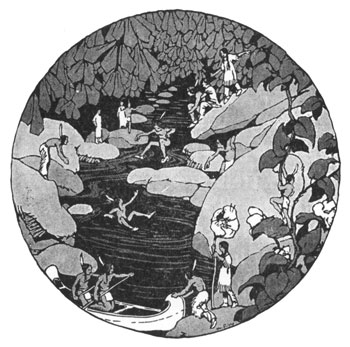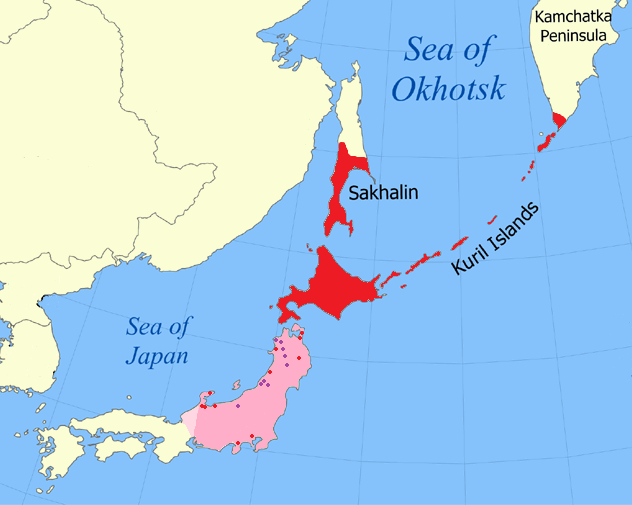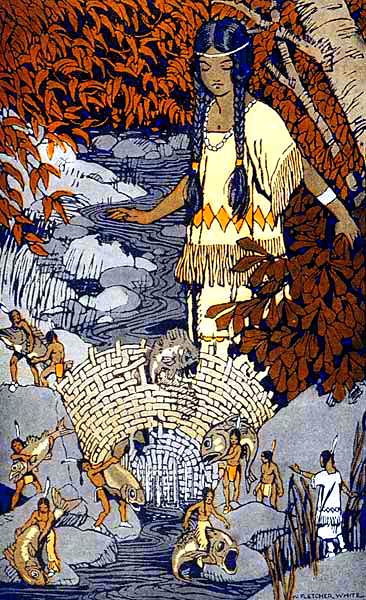|
Koro-pok-guru
Korpokkur (; ), also written Koro-pok-kuru, korobokkuru, korbokkur, or koropokkur, koro-pok-guru, are a race of little people (mythology) in folklore of the Ainu people of the northern Japanese islands. The name is traditionally analysed as a tripartite compound of ''kor'' (" butterbur plant"), ''pok'' ("under, below"), and ''kur'' ("person") and interpreted to mean "people below the leaves of the Fuki" in the Ainu language. The Ainu believe that the ''korpokkur'' were the people who lived in the Ainu land before the Ainu themselves lived there. They were short of stature, agile, and skilled at fishing. They lived in pits with roofs made from butterbur leaves. Long ago, the ''korpokkur'' were on good terms with the Ainu, and would send them deer, fish, and other game and exchange goods with them. The little people hated to be seen, however, so they would stealthily make their deliveries under the cover of night. One day, a young Ainu man decided he wanted to see a ''korpokkur ... [...More Info...] [...Related Items...] OR: [Wikipedia] [Google] [Baidu] |
Koro-pok-guru Photo 01
Korpokkur (; ), also written Koro-pok-kuru, korobokkuru, korbokkur, or koropokkur, koro-pok-guru, are a race of little people (mythology) in folklore of the Ainu people of the northern Japanese islands. The name is traditionally analysed as a tripartite compound of ''kor'' (" butterbur plant"), ''pok'' ("under, below"), and ''kur'' ("person") and interpreted to mean "people below the leaves of the Fuki" in the Ainu language. The Ainu believe that the ''korpokkur'' were the people who lived in the Ainu land before the Ainu themselves lived there. They were short of stature, agile, and skilled at fishing. They lived in pits with roofs made from butterbur leaves. Long ago, the ''korpokkur'' were on good terms with the Ainu, and would send them deer, fish, and other game and exchange goods with them. The little people hated to be seen, however, so they would stealthily make their deliveries under the cover of night. One day, a young Ainu man decided he wanted to see a ''korpokkur'' f ... [...More Info...] [...Related Items...] OR: [Wikipedia] [Google] [Baidu] |
Kuril Islands
The Kuril Islands or Kurile Islands are a volcanic archipelago administered as part of Sakhalin Oblast in the Russian Far East. The islands stretch approximately northeast from Hokkaido in Japan to Kamchatka Peninsula in Russia, separating the Sea of Okhotsk from the north Pacific Ocean. There are 56 islands and many minor islets. The Kuril Islands consist of the Greater Kuril Chain and, at the southwest end, the parallel Lesser Kuril Chain. The group termed the 'South Kurils' consists of those of the Lesser Kuril Chain together with Kunashir and Iturup in the Greater Kuril Chain. The Vries Strait between Iturup and Urup forms the Miyabe Line dividing the North and South Kurils. The Kuril Islands cover an area of around , with a population of roughly 20,000. The islands have been under Russian administration since their Invasion of the Kuril Islands, 1945 invasion by the Soviet Union near the end of World War II. Japan claims the four southernmost islands, including two of the ... [...More Info...] [...Related Items...] OR: [Wikipedia] [Google] [Baidu] |
11th Edition Of The Encyclopædia Britannica
In music theory, an eleventh is a compound interval consisting of an octave plus a fourth. A perfect eleventh spans 17 and the augmented eleventh 18 semitones, or 10 steps in a diatonic scale. Since there are only seven degrees in a diatonic scale, the eleventh degree is the same as the subdominant (IV). The eleventh is considered highly dissonant with the major third. An eleventh chord is the stacking of five thirds in the span of an eleventh. In common practice tonality, it usually had subdominant function as minor eleventh chord on the second degree (supertonic) of the major scale. See also *Eleventh chord *Extended chord In music, extended chords are certain Chord (music), chords (built from third (chord), thirds) or triad (music), triads with notes ''extended'', or added, beyond the seventh (chord), seventh. Ninth chord, Ninth, Eleventh chord, eleventh, and T ... References Chord factors Fourths (music) Compound intervals {{music-theory-stub ... [...More Info...] [...Related Items...] OR: [Wikipedia] [Google] [Baidu] |
Yokohama
is the List of cities in Japan, second-largest city in Japan by population as well as by area, and the country's most populous Municipalities of Japan, municipality. It is the capital and most populous city in Kanagawa Prefecture, with a population of 3.7 million in 2023. It lies on Tokyo Bay, south of Tokyo, in the Kantō region of the main island of Honshu. Yokohama is also the major economic, cultural, and commercial hub of the Greater Tokyo Area along the Keihin region, Keihin Industrial Zone. Yokohama was one of the cities to open for trade with the Western world, West following the 1859 end of the Sakoku, policy of seclusion and has since been known as a cosmopolitan port city, after Kobe opened in 1853. Yokohama is the home of many Japan's firsts in the Meiji (era), Meiji period, including the first foreign trading port and Chinatown (1859), European-style sport venues (1860s), English-language newspaper (1861), confectionery and beer manufacturing (1865), daily newspap ... [...More Info...] [...Related Items...] OR: [Wikipedia] [Google] [Baidu] |
Little People (mythology)
Little people have been part of the folklore of many cultures in human history, including Ireland, Greece, the Philippines, the Hawaiian Islands, New Zealand, Flores, Flores Island, Indonesia, and Indigenous peoples of the Americas, Native Americans. Native American folklore The indigenous peoples of the Americas, Native peoples of North America told legends of a race of "little people" who lived in the woods near sandy hills and sometimes near rocks located along large bodies of water, such as the Great Lakes. Often described as "hairy-faced dwarfs" in stories, petroglyph illustrations show them with horns on their head and traveling in a group of 5 to 7 per canoe. The Pryor Mountains of Montana and Wyoming are said to house "fairy rings" Other legends say the little people, if seen by an adult human, would beg them not to say anything of their existence and would reward those who kept their word by helping them and their family out in times of need. From tribe to tribe there ... [...More Info...] [...Related Items...] OR: [Wikipedia] [Google] [Baidu] |
Nivkh People
The Nivkh, or Gilyak (also Nivkhs or Nivkhi, or Gilyaks; ethnonym: Нивхгу, ''Nʼivxgu'' (Amur) or Ниғвңгун, ''Nʼiɣvŋgun'' (E. Sakhalin) "the people"), are an indigenous ethnic group inhabiting the northern half of Sakhalin Island and the lower Amur River and coast on the adjacent Russian mainland. Historically, they may have inhabited parts of Manchuria. Nivkh were traditionally fishermen, hunters, and dog breeders. They were semi-nomadic, living near the coasts in the summer and wintering inland along streams and rivers to catch salmon. The land the Nivkh inhabit is characterized as taiga forest with cold snow-laden winters and mild summers with sparse tree cover. The Nivkh are believed to be the original inhabitants of the region, and to derive from a proposed Neolithic people that migrated from the Transbaikal region during the Late Pleistocene.Fitzhugh, William, and Durbreui pp.39, 40 The Nivkh had long maintained trade and cultural relations with neigh ... [...More Info...] [...Related Items...] OR: [Wikipedia] [Google] [Baidu] |
John Batchelor (missionary)
Archdeacon John Batchelor, D.D., OBE (20 March 1855 – 2 April 1944) was an Anglican English missionary to the Ainu people of Japan until 1941. First sent under the auspices of the Church Missionary Society of the Church of England, Batchelor lived from 1877 to 1941 among the indigenous Ainu communities in the northern Japanese island of Hokkaido. He was a charismatic and iconoclastic missionary for the Anglican Church in Japan and published highly regarded work on the language and culture of the Ainu people. Batchelor only reluctantly left Japan at the outbreak of the Second World War in the Pacific in 1941. Early life and missionary career John Batchelor was born in Uckfield, East Sussex son of William Batchelor, a local tailor and parish clerk. Batchelor attended Uckfield Grammar School and with the support of the Rev. E.T. Cardale was accepted as a candidate for study at the Church Missionary Society College, Islington. On 22 September 1875, Batchelor set out wi ... [...More Info...] [...Related Items...] OR: [Wikipedia] [Google] [Baidu] |
Sakhalin
Sakhalin ( rus, Сахали́н, p=səxɐˈlʲin) is an island in Northeast Asia. Its north coast lies off the southeastern coast of Khabarovsk Krai in Russia, while its southern tip lies north of the Japanese island of Hokkaido. An island of the West Pacific, Sakhalin divides the Sea of Okhotsk to its east from the Sea of Japan to its southwest. It is administered as part of Sakhalin Oblast and is the largest island of Russia, with an area of . The island has a population of roughly 500,000, the majority of whom are Russians. The indigenous peoples of the island are the Ainu, Oroks, and Nivkhs, who are now present in very small numbers. The island's name is derived from the Manchu word ''Sahaliyan'' (), which was the name of the Qing dynasty city of Aigun. The Ainu people of Sakhalin paid tribute to the Yuan, Ming, and Qing dynasties and accepted official appointments from them. Sometimes the relationship was forced but control from dynasties in China was loose ... [...More Info...] [...Related Items...] OR: [Wikipedia] [Google] [Baidu] |
Okhotsk Culture
The Okhotsk culture is an archaeological coastal fishing and hunter-gatherer culture that developed around the southern coastal regions of the Sea of Okhotsk, including Sakhalin, northeastern Hokkaido, and the Kuril Islands during the last half of the first millennium to the early part of the second. The Okhotsk are often associated to be the ancestors of the Nivkhs, while others argue them to be identified with early Ainu speakers. It is suggested that the bear cult, a practice shared by various Northern Eurasian peoples, the Ainu and the Nivkhs, was an important element of the Okhotsk culture but was uncommon in Jomon period Japan. Archaeological evidence indicates that the Okhotsk culture proper originated in the 5th century AD from the Susuya culture of southern Sakhalin and northwestern Hokkaido. Etymology The Okhotsk culture is named after the eponymous Sea of Okhotsk, which is named after the Okhota river, which is in turn named after the Even word () meaning "ri ... [...More Info...] [...Related Items...] OR: [Wikipedia] [Google] [Baidu] |
Little People (mythology)
Little people have been part of the folklore of many cultures in human history, including Ireland, Greece, the Philippines, the Hawaiian Islands, New Zealand, Flores, Flores Island, Indonesia, and Indigenous peoples of the Americas, Native Americans. Native American folklore The indigenous peoples of the Americas, Native peoples of North America told legends of a race of "little people" who lived in the woods near sandy hills and sometimes near rocks located along large bodies of water, such as the Great Lakes. Often described as "hairy-faced dwarfs" in stories, petroglyph illustrations show them with horns on their head and traveling in a group of 5 to 7 per canoe. The Pryor Mountains of Montana and Wyoming are said to house "fairy rings" Other legends say the little people, if seen by an adult human, would beg them not to say anything of their existence and would reward those who kept their word by helping them and their family out in times of need. From tribe to tribe there ... [...More Info...] [...Related Items...] OR: [Wikipedia] [Google] [Baidu] |
Aleutian Islands
The Aleutian Islands ( ; ; , "land of the Aleuts"; possibly from the Chukchi language, Chukchi ''aliat'', or "island")—also called the Aleut Islands, Aleutic Islands, or, before Alaska Purchase, 1867, the Catherine Archipelago—are a chain of 14 main, larger volcanic islands and 55 smaller ones. Most of the Aleutian Islands belong to the U.S. state of Alaska, with the archipelago encompassing the Aleutians West Census Area, Alaska, Aleutians West Census Area and the Aleutians East Borough, Alaska, Aleutians East Borough. The Commander Islands, located further to the west, belong to the Russian Federal subjects of Russia, federal subject of Kamchatka Krai, of the Russian Far East. The islands form part of the Aleutian Arc of the Northern Pacific Ocean, and occupy a land area of 6,821 sq mi (17,666 km2) that extends westward roughly from the Alaska Peninsula, Alaskan Peninsula mainland, in the direction of the Kamchatka Peninsula; the archipelago acts as a border between ... [...More Info...] [...Related Items...] OR: [Wikipedia] [Google] [Baidu] |






